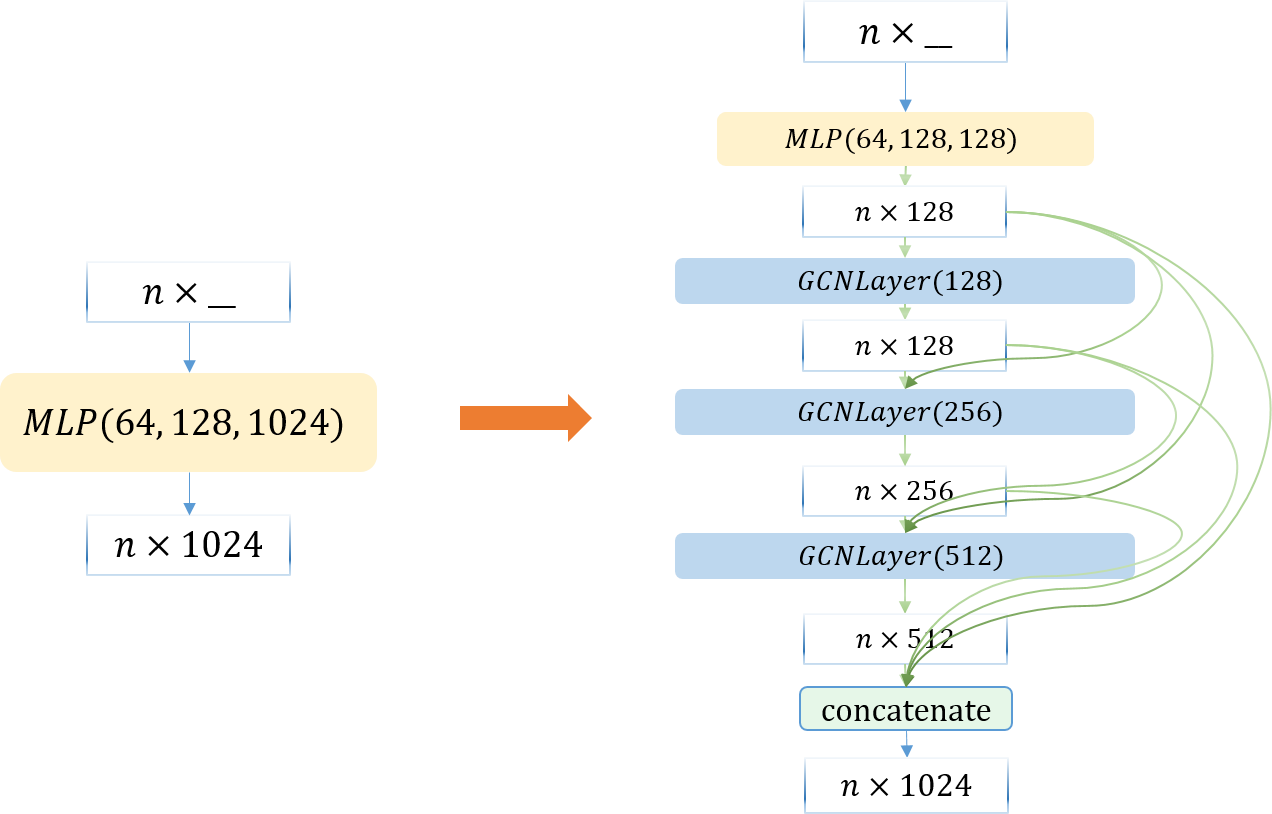This is a project using PointNet and GCNs for pointcloud classification. We implement the original PointNet[1] and make some attempts on incorporating graph convolutional networks[2] into PointNet. Both models are trained and tested on the ModelNet40[3] Dataset.
This is an illustration of PointNet, taken from Figure 2 in [1]. The max-pooling operation aggregates the local feature from each point and ensures permutation invariance. The T-Net are a mini version of PointNet, consisting of a shared MLP(64, 128, 1024), a max-pooling operator and a MLP(512, 256, k×k), which regress the n×k input to a k×k transform.
To incorporate graph convolutional networks, I modified the three MLP(64, 128, 1024) s (one in the main PointNet, two in TNets) by adding GCN layers, illustrated as follows. There are also dense connections between the GCN layers, combining features at different levels. To compare their performances, their output dimensions are kept identical (both are 1024). In addition, GCNs require graphs as an extra input, which are constructed by a thresholded Gaussian kernel weighting function. Hopefully the modification will endow the network with more capacity to capture structural information, and thus result in better performances.
We implement both models in pytorch. Codes are stored in Models/PointNet/ and Models/PointNet+GCN, respectively. The dataset classes in Models/*/data.py are modified from https://github.com/WangYueFt/dgcnn/blob/master/pytorch/data.py. The pytorch implementation for GCN ( Models/PointNet+GCN/layers.py and the class GCN inModels/PointNet+GCN/models.py) are borrowed from https://github.com/tkipf/pygcn/blob/master/pygcn/layer.py.
Similar to [1], an regularization loss term (with weight 0.001) encouraging the 64-by-64 feature transform matrix to be close to an orthonormal matrix is added to the total loss. We use Adam optimizer, with learning rate initially set as 0.001 and decayed by 0.95 every epoch. We test both models for n (#points) = 128, 256, 512, 1024.
Results. The results of both models are listed below.
| PointNet | PointNet+GCN | |
|---|---|---|
| n=128 | 86.7099% | 87.6823% |
| n=256 | 87.2771% | 87.4392% |
| n=512 | 87.3582% | 87.4797% |
| n=1024 | 89.5057% | 88.5332% |
The overall accuracy over 40 classes of PointNet is comparable to the official results given by [1]. The GCN version performs slightly better than PointNet when n=128, 256, 512, but worse when n=1024. Noting than the relationships between the points are important especially when n is small, the results indicate that graph convolution layers probably play a role in capturing structural information. However, we have to admit that when n is large, the training of GCNs become really inefficient, and it is still possible that delicate hyper-parameter tuning may result in better accuracies and lead to more evident conclusions.
First switch the working directory, by
cd Models/"PointNet" cd Models/"PointNet+GCN" Run
python train.py -lr=1e-3 -n=1024 --model=PointNet.ptpython train.py -lr=1e-3 -n=1024 --model=PointNetGCN.ptfor training. The ModelNet40 dataset will be automatically downloaded (you can also download it manually from https://shapenet.cs.stanford.edu/media/modelnet40_ply_hdf5_2048.zip , and unzip the file to ./Datasets/ directory).
The trained model will be stored in PointNet.pt or PointNetGCN.pt.
Run
python test.py -n=1024 --model=PointNet.ptpython test.py -n=1024 --model=PointNetGCN.ptfor testing the trained model (loaded from PointNet.pt or PointNetGCN.pt).
If you want to use our pretrained models, please download them from the following links:
Please save the *.pt files in Models/"PointNet" and Models/"PointNet+GCN", rename them as PointNet.pt and PointNetGCN.pt, respectively, and run the previous testing command.
[1] Charles, R. Q., Su, H., Kaichun, M., & Guibas, L. J. (2017). PointNet: Deep Learning on Point Sets for 3D Classification and Segmentation. computer vision and pattern recognition.
[2] Kipf, T., & Welling, M. (2017). Semi-Supervised Classification with Graph Convolutional Networks. international conference on learning representations.
[3] Wu, Z., Song, S., Khosla, A., Yu, F., Zhang, L., Tang, X., & Xiao, J. (2015). 3D ShapeNets: A deep representation for volumetric shapes. computer vision and pattern recognition.

